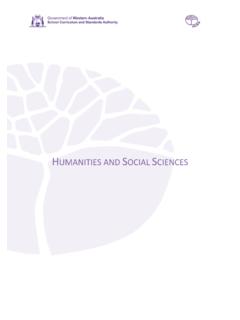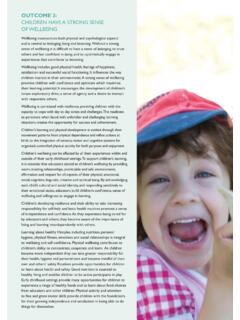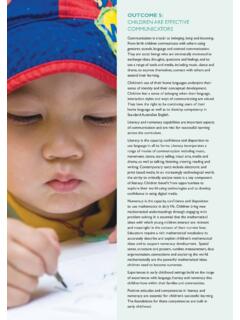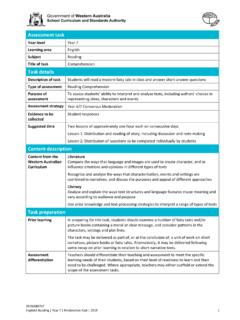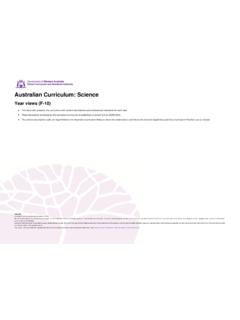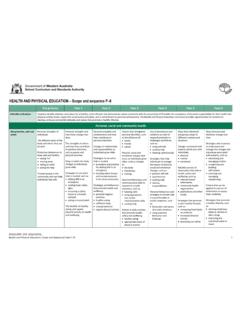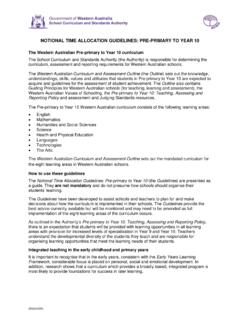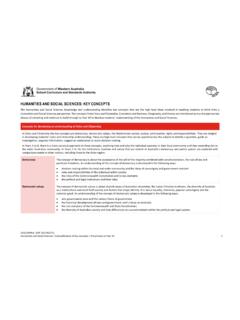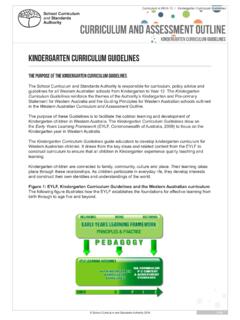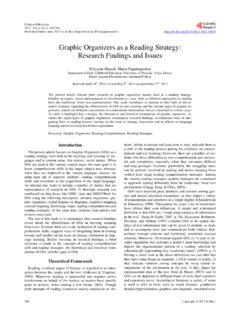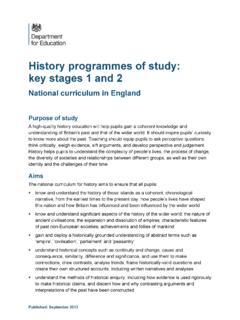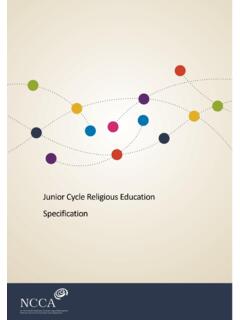Transcription of SAMPLE TEACHING AND LEARNING OUTLINE
1 SAMPLE TEACHING AND LEARNING OUTLINE ENGLISH YEAR 7 2018/21089v2 English | Year 7 | SAMPLE TEACHING and LEARNING OUTLINE 1 Copyright School Curriculum and Standards Authority, 2018 This document apart from any third party copyright material contained in it may be freely copied, or communicated on an intranet, for non-commercial purposes in educational institutions, provided that the School Curriculum and Standards Authority is acknowledged as the copyright owner, and that the Authority s moral rights are not infringed. Copying or communication for any other purpose can be done only within the terms of the Copyright Act 1968 or with prior written permission of the School Curriculum and Standards Authority.
2 Copying or communication of any third party copyright material can be done only within the terms of the Copyright Act 1968 or with permission of the copyright owners. Any content in this document that has been derived from the Australian Curriculum may be used under the terms of the Creative Commons Attribution International (CC BY) licence. Disclaimer Any resources such as texts, websites and so on that may be referred to in this document are provided as examples of resources that teachers can use to support their TEACHING and LEARNING programs. Their inclusion does not imply that they are mandatory or that they are the only resources relevant to the LEARNING area syllabus English | Year 7 | SAMPLE TEACHING and LEARNING OUTLINE 2 The following TEACHING and LEARNING OUTLINE shows one possible approach to planning for the delivery of the Year 7 English Curriculum.
3 It includes suggested assessment tasks, aligned to the curriculum content that would be delivered in the related units of work. When planning for the delivery of English curriculum, a mix of assessments should be considered, ensuring there is adequate coverage of Reading, Writing, Viewing, Speaking and Listening. Timing is a guide only, and can be adjusted to suit the needs of the students and teacher preference. All texts are suggestions only, and tasks can be adapted to suit different topics and texts. Across the planning for Years 7 10 teachers should ensure that students study a wide variety of text choices, covering the breadth outlined in the year-level descriptions, as well as a wide variety of genres. English | Year 7 | SAMPLE TEACHING and LEARNING OUTLINE 3 Timeline Western Australian Curriculum Content Texts/Resources/Text Types Assessment (Mode) Semester 1 2 (ongoing) Language Understand the use of punctuation to support meaning in complex sentences with prepositional phrases and embedded clauses (ACELA1532) Recognise and understand that subordinate clauses embedded within noun groups/phrases are a common feature of written sentence structures and increase the density of information (ACELA1534)
4 Understand how to use spelling rules and word origins, for example Greek and Latin roots, base words, suffixes, prefixes, spelling patterns and generalisations to learn new words and how to spell them (ACELA1539) Understand how language is used to evaluate texts and how evaluations about a text can be substantiated by reference to the text and other sources (ACELA1782) Literacy Edit for meaning by removing repetition, refining ideas, reordering sentences and adding or substituting words for impact (ACELY1726) Consolidate a personal handwriting style that is legible, fluent and automatic and supports writing for extended periods (ACELY1727) Literature Create literary texts that adapt stylistic features encountered in other texts, for example, narrative viewpoint, structure of stanzas, contrast and juxtaposition (ACELT1625) Reflect on ideas and opinions about characters, settings and events in literary texts, identifying areas of agreement and difference with others and justifying a point of view (ACELT1620) Multi-modal (visual and written) prompts Focus on NAPLAN-style persuasive and narrative writing techniques and reading comprehension in Term 1, use diverse writing and reading formats and tasks in Terms 2 4 Task 1.
5 Writing and Reading Writing and reading journal Students will complete regular responses to writing prompts in a writing folio. These prompts may relate to syllabus concepts or studied texts. Writing will be completed in class, under timed conditions. Students will be taught a range of strategies to edit, proofread and improve their written work and their demonstration of reading comprehension and the aesthetic appreciation of read texts. Students will also participate in an ongoing reading program throughout the year, involving the regular selection of books for reading from the school and classroom libraries, as well as other sources the student chooses. Students will write about their chosen reading in the journal, focusing on sharing their experience of the reading and the aesthetics of the text.
6 (Teachers may advise students to separate their journal into two sections, one for reading and one for writing, to assist with assessment judgements.) This folio of written work will be assessed in each semester. English | Year 7 | SAMPLE TEACHING and LEARNING OUTLINE 4 Discuss aspects of texts, for example their aesthetic and social value, using relevant and appropriate metalanguage (ACELT1803) Term 1 Weeks 1 4 Literacy Use prior knowledge and text processing strategies to interpret a range of types of texts (ACELY1722) Edit for meaning by removing repetition, refining ideas, reordering sentences and adding or substituting words for impact (ACELY1726) Literature Reflect on ideas and opinions about characters, settings and events in literary texts, identifying areas of agreement and difference with others and justifying a point of view (ACELT1620)
7 Recognise and analyse the ways that characterisation, events and settings are combined in narratives, and discuss the purposes and appeal of different approaches (ACELT1622) Create literary texts that adapt stylistic features encountered in other texts, for example, narrative viewpoint, structure of stanzas, contrast and juxtaposition (ACELT1625) Non-fiction autobiographical texts Extracts by Anne Frank, Sally Morgan, Bill Bryson, etc. Task booklet Task 2: Writing Personal recount Using the task booklet and knowledge of narrative features studied, students will choose an important event that has happened at school, at home, or on the holidays, and write an extended narrative or recount, telling their reader what happened and how they felt about it.
8 The students will plan, draft, edit and submit their autobiographical narratives (personal recounts). Term 1 Weeks 5 8 Language Understand how accents, styles of speech and idioms express and create personal and social identities (ACELA1529) Understand and explain how the text structures and language features of texts become more complex in informative and persuasive texts and identify underlying structures such as taxonomies, cause and effect, and extended metaphors (ACELA1531) Analyse how point of view is generated in visual texts by means of choices, for example gaze, angle and social distance (ACELA1764) Film study and review Film with a sustainability focus, for example: WALL-E (2008) Landfill Harmonic (2015) Isle of Dogs (2018) The Lorax (2012) Free Willy (1993) Film Conventions Booklet Task Booklet Print and online film reviews (various) Task 6: Viewing, Writing Film review Using the task preparation and film conventions booklets, students are to build on what they have learnt about summarising and note making and will further develop these skills while viewing a film chosen by the teacher.
9 They will then write a film review from their own notes and research. The students will draft and edit their film review and submit the final copy of their review with all plans, notes and draft for assessment. English | Year 7 | SAMPLE TEACHING and LEARNING OUTLINE 5 Literacy Analyse and explain the effect of technological innovations on texts, particularly media texts (ACELY1765) Literature Compare the ways that language and images are used to create character, and to influence emotions and opinions in different types of texts (ACELT1621) Understand, interpret and discuss how language is compressed to produce a dramatic effect in film or drama, and to create layers of meaning in poetry, for example haiku, tankas, couplets, free verse and verse novels (ACELT1623)
10 Term 1 Week 9 Term 2 Week 4 Language Understand how modality is achieved through discriminating choices in modal verbs, adverbs, adjectives and nouns (ACELA1536) Investigate vocabulary typical of extended and more academic texts and the role of abstract nouns, classification, description and generalisation in building specialised knowledge through language (ACELA1537) Literacy Use comprehension strategies to interpret, analyse and synthesise ideas and information, critiquing ideas and issues from a variety of textual sources (ACELY1723) Informative speeches Guest speaker: local Aboriginal elder to discuss sustainability from an indigenous perspective (alternative option: use an online video on a sustainability topic) Affiliated online resources Task booklet NAPLAN online resource materials Task 4: Listening, Writing Summary of sustainability talk Using the task preparation booklet, students will research the sustainability topic.
